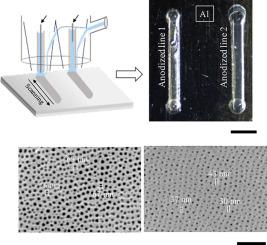Journal of Advanced Research ( IF 11.4 ) Pub Date : 2020-06-27 , DOI: 10.1016/j.jare.2020.06.019 Muhammad Bilal 1 , Masatoshi Sakairi 2

|
Introduction
Recent advancements in 3D printing technology allow us to design and fabricate customized droplets cells for localized electrochemical patterning.
Objectives
In this study, 3D printed solution-flow type microdroplet cell (Sf-MDC) is proposed for localized anodizing of two different regions on Al surface. The effect of printing orientation on 3D printing parameters is elucidated to minimize the resin consumption, printing time and material wastage. The capability of Sf-MDC to fabricate porous alumina patterns with adjustable pore size and thickness is explored by varying the length of Pt wire inside each capillary.
Methods
The Sf-MDC was optimally fabricated using 3D printer at the highest possible resolution. The Al specimens were electropolished in 13.6 kmolm−3 CH3COOH/2.56 kmolm−3 HClO4 at 278 K and 28 V for 145 s. 0.22 kmolm−3 oxalic acid (COOH)2 solution was prepared for anodizing. The specimen was set on pulse-XYZ stage controller and anodized (at 50 V and 323 K) using the Sf-MDC.
Results
Anodizing with Sf-MDC resulted in the formation of two uniformly sized porous alumina lines on the specimen. Porous alumina lines exhibited similar pore geometry, interpore distance and pores arrangement, suggesting uniform supply of current to both the droplets. Layered-type cross-sectional structure with each layer having a thickness of 2.7 mm was formed for both the porous alumina lines. By varying the length of Pt wire inside each capillary, porous alumina lines with different porous structure and oxide thickness were simultaneously fabricated.
Conclusions
Simultaneous anodizing with Sf-MDC can be applied for fast fabrication of porous alumina filters with different porous structure and for various patterning applications.
中文翻译:

用于同步区域选择性阳极氧化的 3D 打印溶液流动型微滴池
介绍
3D 打印技术的最新进展使我们能够设计和制造用于局部电化学图案的定制液滴单元。
目标
在这项研究中,提出了 3D 打印溶液流型微滴单元(Sf-MDC)用于铝表面两个不同区域的局部阳极氧化。阐明了打印方向对 3D 打印参数的影响,以最大限度地减少树脂消耗、打印时间和材料浪费。通过改变每个毛细管内 Pt 丝的长度,探索了 Sf-MDC 制造孔径和厚度可调的多孔氧化铝图案的能力。
方法
Sf-MDC 使用 3D 打印机以尽可能高的分辨率进行优化制造。将Al样品在13.6 kmolm -3 CH3COOH/2.56 kmolm -3 HClO 4中在278 K和28 V下电解抛光145 s。制备0.22kmolm -3草酸(COOH) 2溶液用于阳极氧化。将样本设置在脉冲 XYZ 平台控制器上并使用 Sf-MDC 进行阳极氧化(50 V 和 323 K)。
结果
使用 Sf-MDC 阳极氧化导致在样品上形成两条尺寸均匀的多孔氧化铝线。多孔氧化铝线表现出相似的孔几何形状、孔间距和孔排列,表明向两个液滴提供均匀的电流。对于两条多孔氧化铝线均形成每层厚度为2.7mm的层状截面结构。通过改变每个毛细管内铂丝的长度,同时制备具有不同多孔结构和氧化物厚度的多孔氧化铝线。
结论
与 Sf-MDC 同步阳极氧化可用于快速制造具有不同多孔结构的多孔氧化铝过滤器和各种图案化应用。









































 京公网安备 11010802027423号
京公网安备 11010802027423号